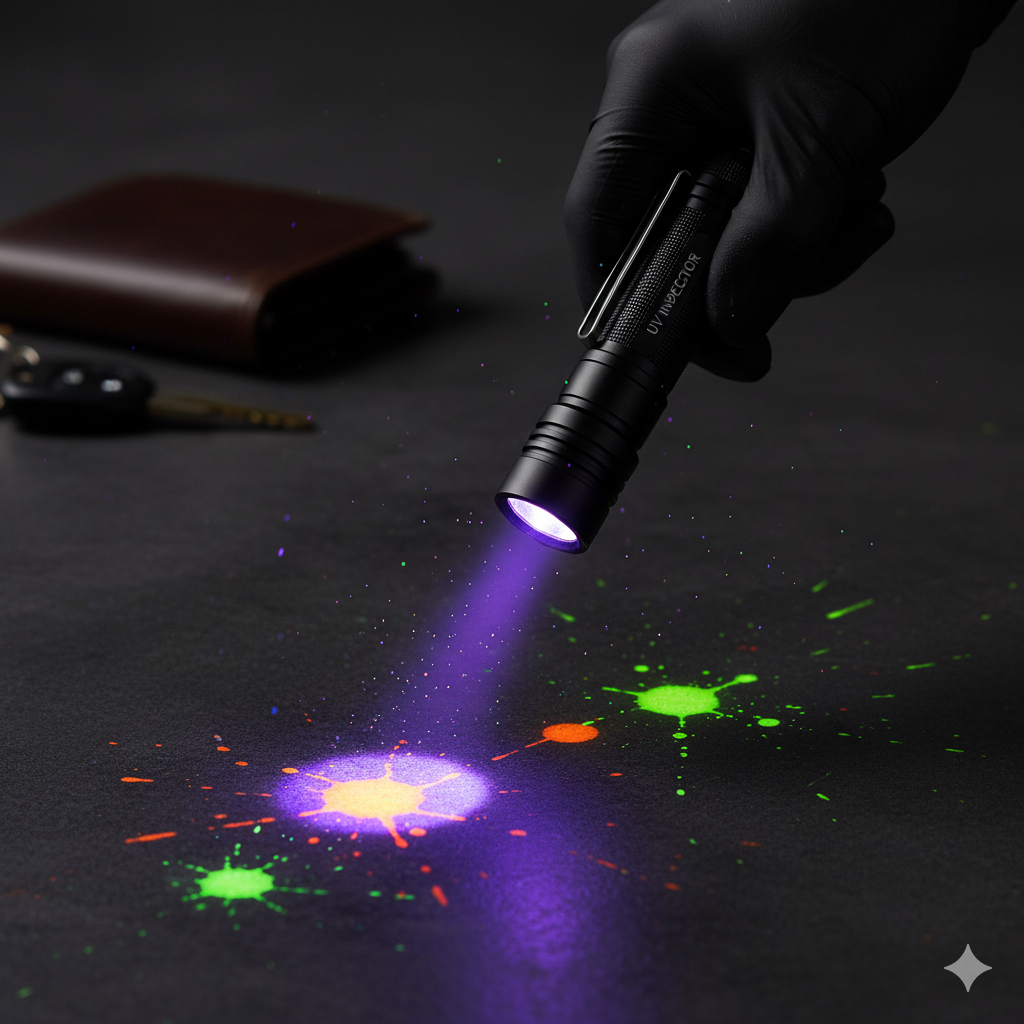The Science Behind UV Flashlights: How Do They Work?
Posted by Raymond on 20th Oct 2025
Ultraviolet (UV) flashlights may look similar to regular torches, but they emit a very different type of light — one that reveals what’s normally invisible to the human eye. From detecting counterfeit currency and pet stains to forensic analysis and mineral exploration, UV flashlights serve a wide range of practical and scientific purposes.
In this article, we’ll dive into how UV flashlights work, the science behind UV light, and how to choose the right model for your needs.
1. What Is UV Light?
Ultraviolet (UV) light is a form of electromagnetic radiation with wavelengths shorter than visible light but longer than X-rays — typically ranging from 100 to 400 nanometers (nm).
It’s divided into three main categories:
| Type of UV Light | Wavelength Range | Common Uses |
|---|---|---|
| UVA | 315–400 nm | Blacklights, curing resins, UV flashlights |
| UVB | 280–315 nm | Disinfection, tanning lamps |
| UVC | 100–280 nm | Germicidal and sterilization devices |
Most UV flashlights emit UVA light, as it is safe for general use and effective for detection tasks like revealing fluorescent materials.
2. How UV Flashlights Work
Unlike regular flashlights that use white LEDs, UV flashlights use LEDs designed to emit ultraviolet wavelengths.
Here’s the simplified process:
-
Power Source – Most UV flashlights are powered by rechargeable lithium-ion or AAA batteries.
-
UV LED Chips – The flashlight’s LEDs are built with semiconductor materials that emit photons in the UV range when energized.
-
Optical Lens – A filter lens allows UV light to pass while blocking most visible light, improving contrast for fluorescent reactions.
-
Emission – When UV light strikes certain materials, it excites their electrons and causes them to fluoresce (emit visible light), revealing hidden patterns, stains, or markings.
? Fun fact: Many minerals and bodily fluids fluoresce under UV light, which is why these flashlights are popular in forensic and cleaning applications.
3. Applications of UV Flashlights
UV flashlights are far more versatile than many realize. Some of their most common uses include:
-
Forensics: Detecting blood, fibers, or residues at crime scenes
-
Pet owners: Finding invisible urine stains or odor sources
-
Currency verification: Identifying counterfeit money or IDs
-
Mineral hunting: Viewing natural fluorescence in rocks and gems
-
Hygiene inspection: Spotting contamination in hotels or restaurants
-
Leak detection: Revealing refrigerant or engine oil leaks with UV dye
For a more detailed overview of how UV technology is used in safety and industry, see this educational overview on ultraviolet radiation from Britannica.
4. UV Flashlights vs. Regular Flashlights
| Feature | UV Flashlight | Regular Flashlight |
|---|---|---|
| Light Type | Ultraviolet (invisible) | Visible white light |
| Primary Function | Detection, inspection | Illumination |
| Fluorescence Detection | Yes | No |
| Battery Life | Often longer (low power LEDs) | Varies with brightness |
| Typical Users | Forensic, industrial, pet owners | General users |
5. How to Choose the Right UV Flashlight
When shopping for a UV flashlight, pay attention to these specifications:
-
Wavelength: 365 nm (best for fluorescence) or 395 nm (budget-friendly)
-
Brightness Output: Higher intensity ensures better visibility
-
Build Material: Aluminum alloy offers durability for outdoor use
-
Power Type: Choose rechargeable UV flashlights for sustainability
-
Portability: Compact or keychain models for everyday carry
If you’re looking for a professional-grade option, explore Tank007’s line of UV and portable flashlights — designed for high performance and durability.
Visit: https://www.tank007store.com/
6. Safety Tips When Using UV Flashlights
Although most UVA flashlights are safe, prolonged exposure can still irritate eyes and skin. Follow these simple safety precautions:
-
Avoid shining directly into eyes.
-
Wear UV-blocking glasses during extended use.
-
Keep away from children.
-
Do not use UVC devices without protection.
Conclusion
UV flashlights are an ingenious application of physics and engineering — revealing hidden details invisible under normal lighting. Whether for hobby, inspection, or professional use, understanding how they work helps you choose the right one for your needs.
As technology advances, we can expect even more efficient, compact, and multi-functional UV flashlights in the coming years.
